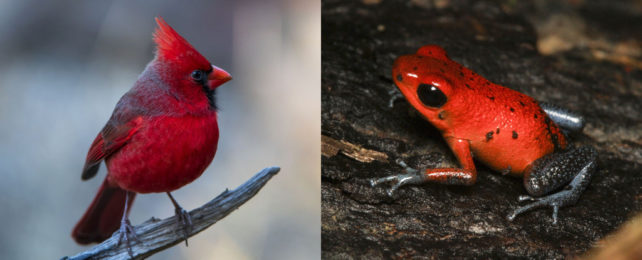Dazzling as it often appears, fashion in the animal kingdom can be frightfully repetitive. There are only so many color templates that scream 'look at me' amid the greys and greens of foliage and muck.
So it should be no surprise that animals often use the same colors for very different purposes.
The brilliant crimson of a male northern cardinal (Cardinalis cardinalis) serves as a signal for potential mates to draw closer; in strawberry poison-dart frogs (Oophaga pumilio), that blast of red is a stern warning to keep away, or you'll ingest a mouthful of powerful, deadly toxin.
Evolutionary biologist Zachary Emberts, currently of Oklahoma State University, and colleague John Wiens of the University of Arizona, wondered what makes the same colors evolve to serve such different purposes in different animals.
They conducted a study of 1,824 species of land vertebrates (aquatic animals can be a whole other kettle of fish), categorizing their coloration as either come-hither or get-lost, and they found the common thread connecting each group.
The come-hither animals, such as birds and lizards, are descended from ancestors that were diurnal, or active during the day. The get-lost animals, such as snakes and amphibians, are descended from nocturnal ancestors.
"Traits that we see today in species can be a result of their evolutionary history," Emberts says. "We were looking for evolutionary patterns, so we did two separate analyses, one that used their current day-night activity and one that used their ancestral day-night activity."
No correlation, they found, exists between day and night activity and the animals' coloration today; instead, the link is purely ancestral. But it's one that seems to be consistent across all terrestrial vertebrates, whose evolution goes back around 350 million years.
"It doesn't matter how a species produces the colors," Wiens says. "The way that a bird makes red is different from how a lizard makes red, but this general pattern of day-night activity still works."
According to the researchers' analysis, most of the ancestors of the animals they studied started out rather plain and drab, evolving their vivid hues over time, and most of them live in environments in which their vivid colors stand out. The most reasonable explanation is that more brightly colored animals were better able to survive, and pass their genetic material onto generations that continued the trend.
Colors analyzed included red, orange, yellow, purple, and blue, and the researchers found that, for all colors except blue, the colorations were pretty equally divided between sex signaling and warning. It's currently unclear what the reason for that could be.
"It's interesting to see that for some colors like red, orange, and yellow, they're used with similar frequency as both a way to avoid predators and as a way for mate attraction," says Emberts.
"On the flip side, blue coloration was more frequently associated with mating as opposed to predator avoidance."
The diurnal animals' coloration makes sense: a flashy animal, in the light of day, is going to be seen by other animals, including potential mates. That may make them bigger targets for predators, too, but it seems like being able to find a mate and reproduce is more important than not being eaten. The females of these species are often drab in comparison, and therefore better able to hide from predators and survive to rear offspring.
But nocturnal animals slither and snoop about in the dark. A male nocturnal snake doesn't have much use for a bright color for sexual signaling if the females can't see it.
"Warning colors have evolved even in species with no eyes," Wiens says. "It's questionable whether most snakes or amphibians can see colors, so their bright colors are generally used for signaling to predators rather than to members of the same species."
Instead, the researchers suggest, the coloration may have evolved as a way to tell diurnal predators who may happen upon the sleeping animal to steer clear. But future research may reveal more details. The team hopes to delve deeper into the evolution of bright colors to see if their functions have changed over time.
In the meantime, though, the research shows that delving into the evolutionary history of animal traits may reveal patterns that are no longer current today.
The team's research has been published in Evolution.
